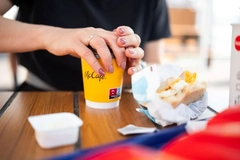Bio-based packaging: Industry accelerates compostable innovations as demand grows

26 Jun 2024 --- Packaging companies are increasingly turning to bio-based solutions in an effort to avoid fossil-based materials. Recycling infrastructure for bio-based and biodegradable products is being scaled up to meet increasing demand, according to Sulapac’s chief product officer, Dr. Heidi Peltola.
Recyclability is on everyone’s agenda, says Peltola. “It has been demonstrated that Sulapac material can be separated from mixed plastic waste streams with standard technologies like NIR (near-infrared spectroscopy).”
“On the other hand, PPWR recognizes Sulapac [materials] among other biodegradables as recyclable material and the European Commission (EC) will be defining the ‘design of recycling criteria’ for these.”
Recycled content is an important requirement for the company’s customers, according to Peltola, especially for cosmetics producers. “Sulapac’s materials are already available with recycled biopolymers, which further decreases their carbon footprint.”
“Using recycled biopolymers instead of virgin ones doesn’t alter the material properties in any way,” she continues.
Meanwhile, Innova Market Insights data indicates that global F&B launches with bio-based packaging had a 60% average annual growth from April 2019 to March 2024.
Europe (59%) was the leading region for these launches, and most frequently, bio-based materials were used for Hot Drink packaging, according to the global market researcher.
Additionally, more than 2 in 3 bio-based packaging launches contained recyclable claims.
Sulapac’s thermoformed packaging inserts (Image credit: Sulapac).Recycled material demands
Sulapac’s latest innovation is Sulapac for thermoforming. “Due to the large volumes, replacing conventional plastic with Sulapac in thermoformed applications creates a huge impact in terms of fossil-based feedstock, microplastics and CO2 emissions avoided,” says Peltola.
Examples of thermoformed products made of Sulapac materials include packaging inserts, logistic trays, beverage cups and food containers.
Another recent addition to the company’s portfolio is the Sulapac Luxe material family, which was developed to replace technical plastic in cosmetic packaging.
“There is a clear demand for Sulapac-like materials in this category as plastics like ABS are extremely difficult to recycle. There are also other environmental concerns, which is why many brands are actively looking for more sustainable alternatives,” explains Peltola.
“Until now, there hasn’t been one that would perform according to the standards, so Sulapac Luxe Flex, in particular, is a game changer in a way.”
Compostable innovations
Meanwhile, Eastman sees companies choosing bio-based packaging when other sustainable approaches such as reduce, reuse and recycle don’t provide adequate solutions, Jeff Carbeck, vice president for Corporate Innovation at Eastman, tells us.
The chemicals company recently launched a family of bio-based polymers called Aventa.
“It is a unique material that combines sustainably sourced wood pulp and acetic acid (vinegar). Aventa stands out because it can utilize recycled content along with sustainably sourced wood pulp, resulting in Aventa Renew,” says Carbeck.
Carbeck explains that the manufacturing process involves breaking down waste plastics that would otherwise end up in a landfill into recycled molecules used to make cellulose acetate pellets.
“When properly formulated, this material can then be molded into various foodservice and food packaging applications that perform comparably to traditional packaging materials,” he says.
“Aventa is certified home and industrially compostable and biodegradable. Once consumers have finished using the packaging, they can dispose of it alongside their food waste in compost bins. Microorganisms readily recognize Aventa as a food source and completely break it down, ensuring that it does not remain as microplastics in the environment,” Carbeck tells us.
R&D for bio-based  Eastman’s Aventa trays (Image credit: Eastman).
Eastman’s Aventa trays (Image credit: Eastman).
Sulapac’s portfolio includes 13 bio-based, biodegradable and technically outstanding materials for injection molding, extrusion, 3D printing and thermoforming.
Sulapac claims to be the first bio-based biodegradable material that can meet the quality standards of the “most demanding” cosmetic players.
In addition to materials designed particularly for the cosmetic sector, the portfolio includes materials for foodservice applications as well, yet their usage is not limited to these. Sulapac materials are also used in furniture, luxury packaging, jewelry and consumer electronics.
Besides the different technical properties needed for specific applications, the portfolio offers freedom of choice in terms of look and feel: the materials have different appearance and touch depending on the size of wood chips used in the recipe. There are also materials like Sulapac Solid, which does not contain any wood.
Peltola says that new material launches can be expected this year.
“Both of the materials we have in the pipeline are something quite different compared to our existing portfolio and provide new opportunities to replace conventional plastic with a truly sustainable option,” she highlights.
“We are also working intensively with our customers on different projects with some exciting launches later this year.”
Carbeck says that Eastman is currently focusing on the foodservice and food packaging industries.
“Our targeted commercial applications include straws, cutlery and protein trays. We have noticed a growing demand for compostable products, and Aventa is being recognized as a suitable alternative to conventional plastics in these and other areas.”
By Natalie Schwertheim











